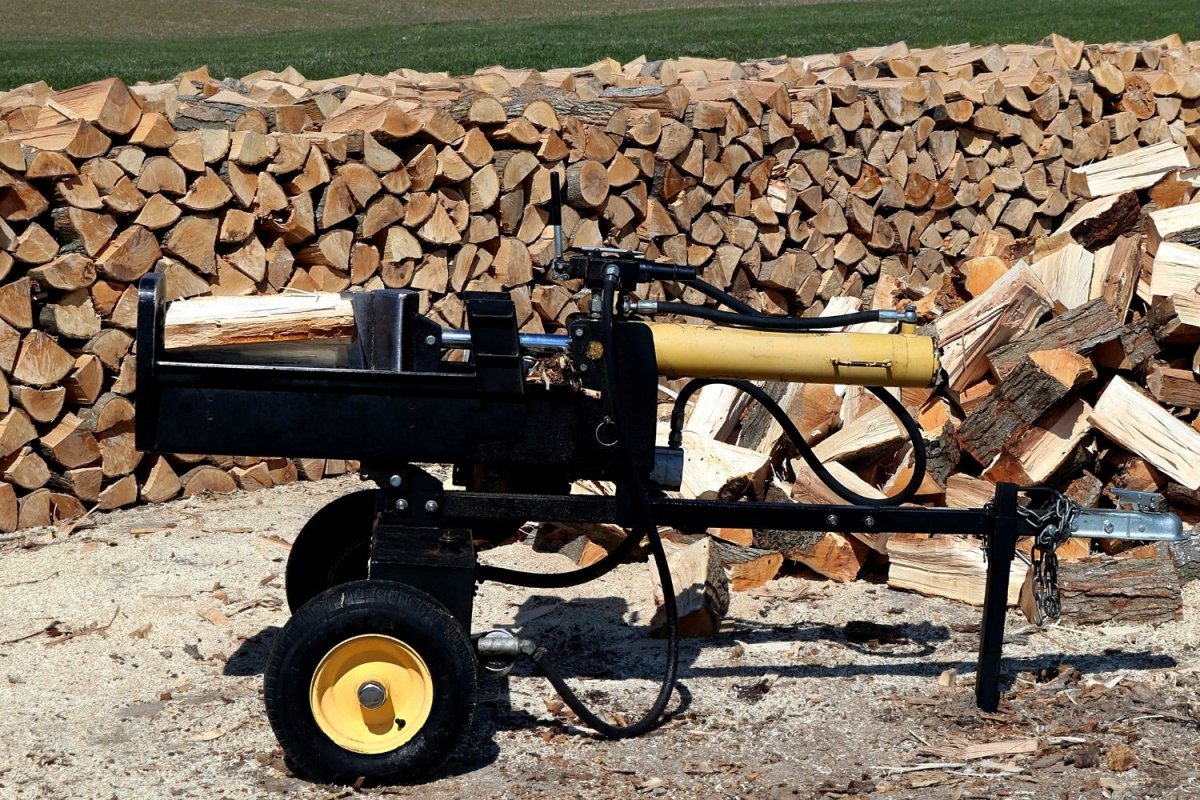
We may earn revenue from the products available on this page and participate in affiliate programs. Learn More ›
Curling up next to a crackling wood fire can be comforting, but the experience doesn’t come cheap. Depending on where people live, it is possible to pay several hundred dollars for a cord (8 feet long by 4 feet wide by 4 feet deep) of split and seasoned firewood. No wonder lots of folks try to save money by chopping their wood.
Trouble is, the tedious, labor-intensive process of swinging an axe can hurt the hands, shoulders, neck, and back. The solution? A log splitter! While trees still have to be felled and cut into logs with a chainsaw, a log splitter takes care of the hard work of creating smaller pieces that will fit perfectly into a firebox.
Keep reading to learn more about these helpful tools and to find out why one of the following models may be the best log splitter for making those winter chores easier.
- BEST OVERALL: Wen 56208 6.5-Ton Electric Log Splitter
- BEST BANG FOR THE BUCK: Fiskars X27 Super Splitting Axe
- BEST FOR KINDLING: Hi-Flame Firewood Kindling Splitter
- BEST MANUAL: Kindling Cracker Firewood Splitter
- BEST VERTICAL: Champion 25-Ton Full Beam Log Splitter
- BEST COMPACT: Kabin Kindle Quick Kindling Log Splitter
- BEST COMMERCIAL: Countyline 25-Ton Horizontal/Vertical Log Splitter
- BEST GAS: Countyline 40-Ton Horizontal/Vertical Log Splitter
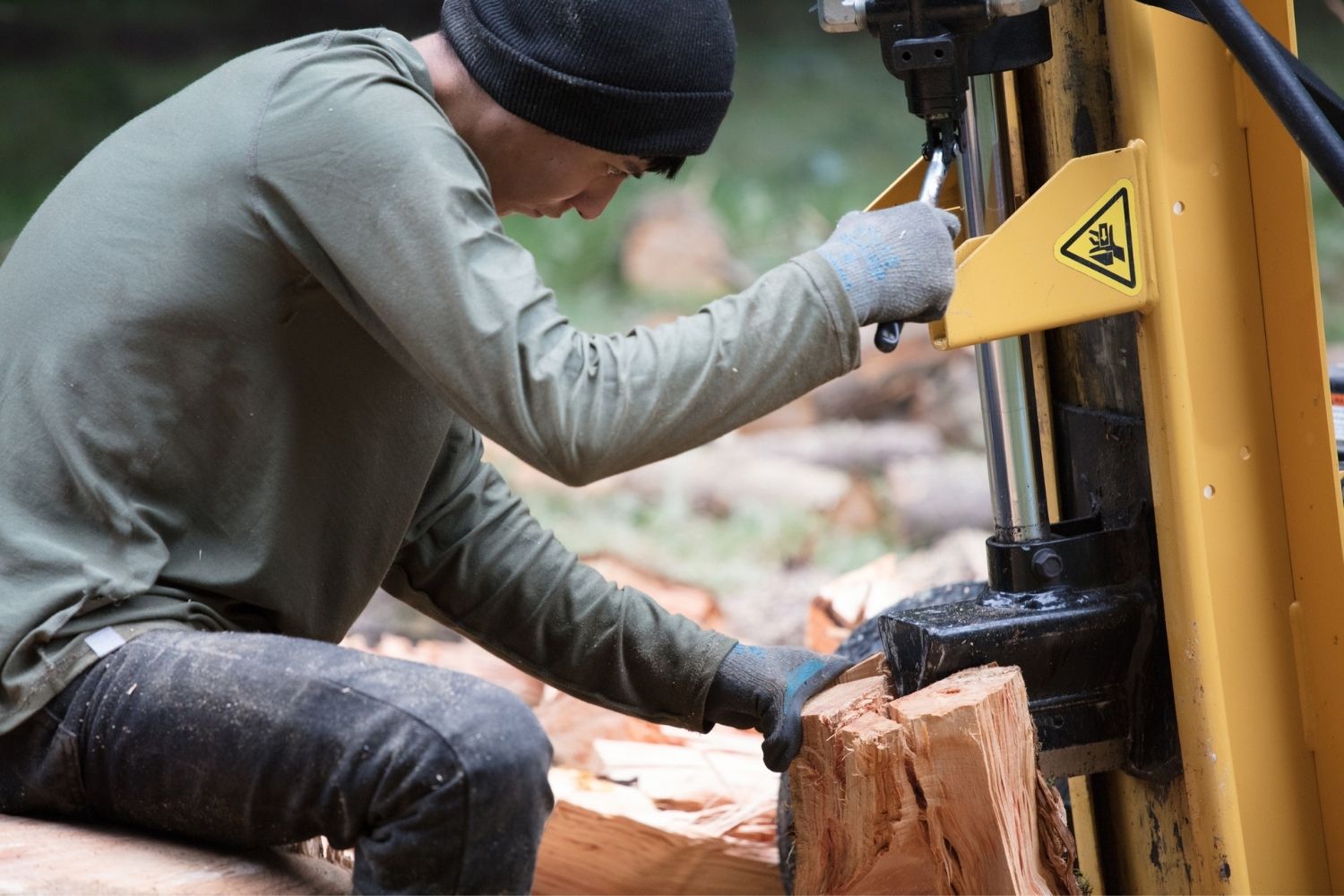
How We Chose the Best Log Splitters
Anyone who has to split wood regularly will likely appreciate the assistance afforded by a log splitter. Whether it’s in the form of a sharp steel wedge or a beefy gas-powered model, all splitters reduce the amount of physical effort needed to split logs for the fireplace or wood-burning stove.
Our list of recommendations gathers the types of log splitters available and offers the top picks in each category—manual, automatic, gas-powered, and electric splitters. Our recommendations offer an ideal choice depending on the tonnage the user requires and the size of the log or piece of wood they are looking to split. In our research, we took care to highlight products that stand out in terms of portability, since we appreciate that log splitters sometimes need to be hauled around to get the job done. As such, our picks all feature suitable transportation options, from towable units to ones with wheels to others that are light enough to be carried around.
Our Top Picks
Time to check out some of the best log splitters available, chosen for performance, quality, and price. Wood splitting needs vary, and some may need a hefty gas log splitter to split enough wood to last all winter, while others may want a small manual log splitter that serves only to further split quartered logs into kindling. No matter the needs, one of the following log splitters should fit the bill.
Best Overall
Wen 56208 6.5-Ton Electric Log Splitter
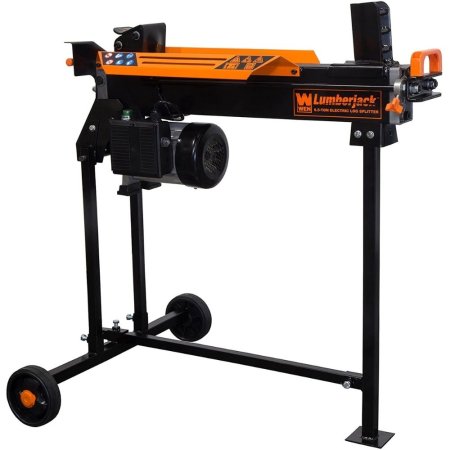
Pros
Cons
Product Specs
- Type: Electric
- Splitting force: 6.5 tons
- Size: 39.25 inches high by 28.25 inches wide by 38.5 inches deep
- Weight: 98 pounds (115 pounds with stand)
Generate up to 13,000 pounds of log-splitting force with the Wen 6.5-ton electric log splitter. This horizontal electric log splitter includes a 34-inch stand for splitting logs at waist level, or it can be placed on the ground to make loading large logs into the cradle easier. The cradle features elevated “wings” to keep logs stable and reduce the risk of a log rolling out.
Because an electric model won’t generate fumes, the Wen log splitter can be used in a garage or a workshop, or with a heavy-duty extension cord for backyard operation. The Wen features a 20-second cycle time and is suitable for splitting logs up to 10 inches in diameter. Its wedge-shaped head splits logs into two halves, which can then be repositioned in the cradle for splitting into quarters.
Get the Wen log splitter at Amazon or The Home Depot.
Best Bang For The Buck
Fiskars X27 Super Splitting Axe
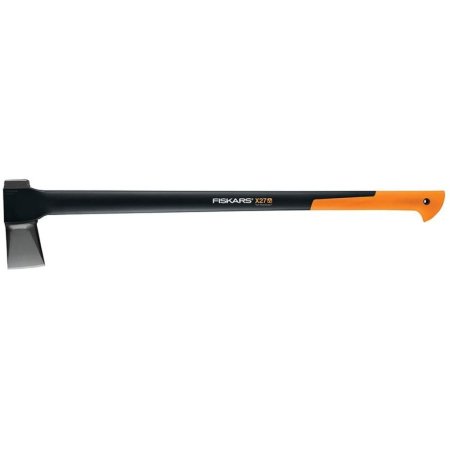
Pros
Cons
Product Specs
- Type: Manual
- Splitting force: Unlisted
- Size: 36.01 inches high by 7.52 inches wide by 2.59 inches deep
- Weight: 6.3 pounds
For those willing to expend a little elbow grease, buying a log splitter doesn’t have to break the bank. Among the most manual of all wood-splitting options, the Fiskars splitting axe weighs just 6.3 pounds and is 36.01 inches high, making it well suited for taller users. Best of all, it comes at an affordable price point.
The Fiskars axe is fully manual, but its advanced bevel convex blade concentrates splitting power with each strike and also makes it easier to pull the blade out of the wood if the split is incomplete. This is a
, designed to increase swing speed and multiply striking power. It comes with a textured, nonslip grip to reduce hand fatigue.
Get the Fiskars log splitter at Amazon, The Home Depot, or Walmart.
Best For Kindling
Hi-Flame Firewood Kindling Splitter
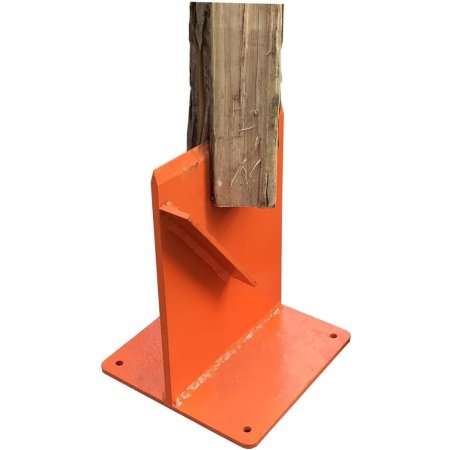
Pros
Cons
Product Specs
- Type: Manual
- Splitting force: Unlisted
- Size: 9.5 inches high by 7 inches square
- Weight: 9 pounds
Standing just 9.5 inches high and weighing in at 9 pounds, the Hi-Flame log splitter is designed for reducing larger pieces from the wood pile into thin, kindling-size pieces, and its small dimensions make it suitable for transporting in a car or truck.
The Hi-Flame splitter is made from bright-orange powder-coated steel and features a sharpened vertical blade welded to a base plate that can be positioned on the ground or bolted to the top of a log stump for added stability. Each side of the vertical blade features a slanted steel guide that directs the split wood at a diagonal angle to reduce the chance of logs getting stuck on the blade. A mallet or maul is required for splitting the firewood.
Get the Hi-Flame log splitter at Amazon.
Best Manual
Kindling Cracker Firewood Splitter
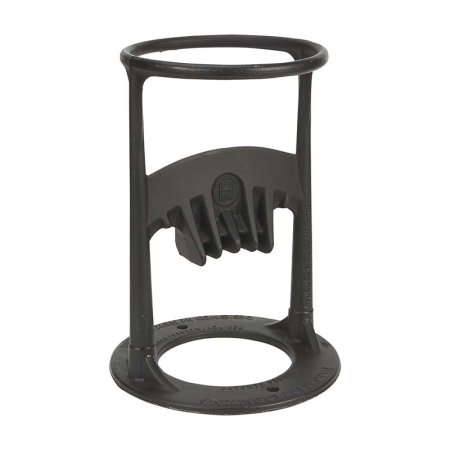
Pros
Cons
Product Specs
- Type: Manual
- Splitting force: Unlisted
- Size: 12 inches high by 6.5 inches in diameter
- Weight: 10 pounds
If a manual approach is preferred but the hope is to increase speed and reduce labor while chopping smaller logs (up to 6.5 inches in diameter), the Kindling Cracker firewood splitter is just the ticket. This manual splitter holds logs in place while the user hits them with a
or mallet—no axe necessary. The Kindling Cracker splitter is designed to be bolted to a heavy board or even to the center of a sturdy tree trunk so it won’t move or shift while in use.
The log is then placed into the circular steel holder, and the user hits it firmly, driving the log downward onto the steel
. This fully manual splitter doesn’t require maintenance, fuel, or electricity, so it can be used anywhere.
Get the Kindling Cracker log splitter at Acme Tools or Northern Tool + Equipment.
Best Vertical
Champion 25-Ton Full Beam Log Splitter
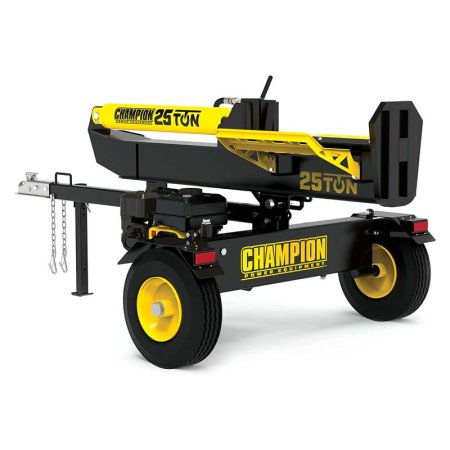
Pros
Cons
Product Specs
- Type: Gas
- Splitting force: 25 tons
- Size: 89.5 inches long by 51.3 inches wide by 39.3 inches high
- Weight: 434.3 pounds
The Champion Power Equipment log splitter provides the ability to switch quickly from horizontal to vertical operation, thus avoiding the need to lift large, heavy logs onto the carriage. This bad boy generates 25 tons of ram force to effortlessly split large logs up to 24 inches in length that weigh up to 100 pounds. The cycle time for splitting each log is just 11 seconds.
This is a gas-powered splitter with a powerful 224cc single-cylinder engine that complies with Environmental Protection Agency (EPA) and California Air Resources Board (CARB) regulations for low emissions. Weighing in at a beefy 434.3 pounds, this heavy-duty log splitter is not easy to lift, but there’s no need. It comes mounted on its wheelbase and includes an ATV/UTV 2-inch ball hitch for pulling it into remote locations.
Get the Champion log splitter at Amazon or Northern Tool+Equipment.
Best Compact
Kabin Kindle Quick Kindling Log Splitter
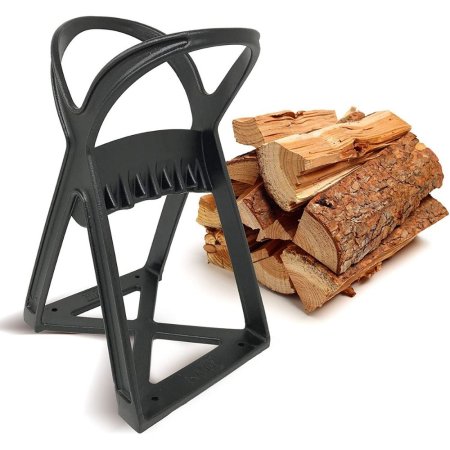
Pros
Cons
Product Specs
- Type: Manual
- Splitting force: Unlisted
- Size: 15.5 inches high by 9 inches wide by 10.25 inches deep
- Weight: 12 pounds
When storing a large log splitter is out of the question, consider the Kabin Kindle quick log manual splitter that weighs just 12 pounds, is a mere 15.5 inches high by 9 inches wide by 10.25 inches deep. This compact manual splitter is portable and well suited to taking on camping trips or just to the
for splitting small logs with a mallet or sledgehammer.
The Kindle Quick is made from solid cast steel in a tripod designed for stability, and it comes with a sharp wedge blade in the center that splits firewood in two, reducing the amount of strike force required to split the wood.
Get the Kabin Kindle log splitter at Amazon or Walmart.
Best Commercial
Countyline 25-Ton Horizontal/Vertical Log Splitter

Pros
Cons
Product Specs
- Type: Gas
- Splitting force: 25 tons
- Size: 90.6 inches long by 47.6 inches wide by 39.4 inches high
- Weight: 490 pounds
The market for 25-ton gas-powered log splitters is very competitive, and most machines in this category offer horizontal and vertical operation. There are a couple of things that set this Countryline model apart. First is the DOT-approved tires, so unlike many that can only be towed across fields, this one is road ready. Second is the excellent 196cc Kohler engine. It is a highly regarded power unit known for reliability, easy starting, and ease of maintenance.
The Countyline 25-ton commercial log splitter can handle logs up to 26 inches long in vertical mode and 36 inches in diameter. The cycle time is 11.5 seconds. The 8-inch flared splitting wedge is designed to be effective in both wet and twisted logs, which other machines can struggle with.
Get the Countyline 25-ton log splitter at Tractor Supply Co.
Best Gas
Countyline 40-Ton Horizontal/Vertical Log Splitter
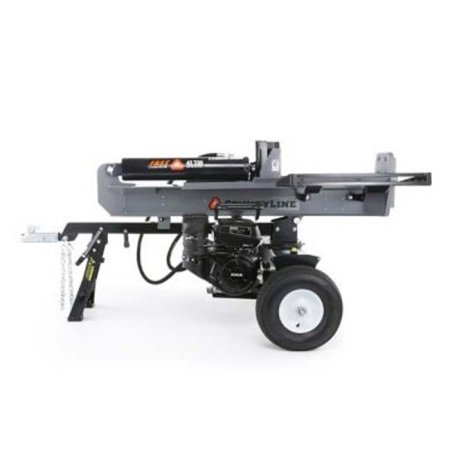
Pros
Cons
Product Specs
- Type: Gas
- Splitting force: 40 tons
- Size: 94.9 inches long by 50.4 inches wide by 47.2 inches high
- Weight: 781 pounds
When it comes to high performance, few log splitters can compete with the 40-ton gas splitter from Countyline. Like many gas models, this option has impressive tonnage combined with horizontal or vertical operation and a cycle time of just 9.5 seconds. That kind of rapid production makes for reliable performance for those who split logs for a living.
Providing the power source for this beast is the 429cc Kohler CommandPro gas motor known for its reliability and durability. Despite the large capacity, it is a low-maintenance, low-emissions unit that is EPA and CARB compliant.
The chassis is fitted with DOT-approved pneumatic tires, so the Countyline 40-ton log splitter can be towed to wherever it is needed.
Get the Countyline 40-ton log splitter at Tractor Supply Co.
Jump to Our Top Picks

What to Consider When Choosing a Log Splitter
The following factors may come into play when determining the best log splitter for individual needs—be it a large-scale power tool or a manual model. A manual hydraulic log splitter does require some labor but not nearly as much as using an axe. Electric splitters or gas-powered models require only that the user lift the log into the cradle.
Types of Log Splitters
Although some are manual, many log splitters are heavy-duty tools that run on hydraulics. Hydraulic fluid is pumped through a cylinder to create enough pressure to force a large steel bar—called a ram—into the end of a log. The ram splits the firewood into halves or quarters, depending on the type of steel blade used.
Unlike manually swinging an axe, which uses force and impact to split a log, the best log splitters use steady, even pressure, causing the logs to split slowly and consistently. A hydraulic log splitter comes in two basic configurations: horizontal splitters and vertical log splitters. Each of the hydraulic splitters has its benefits and considerations.
Horizontal
This type of wood splitter features a horizontal bed or cradle onto which the log is placed. Using a steel ram, the splitter pushes the log into a sharpened steel blade at the other end, which splits the log lengthwise. Horizontal log splitters are the most common type and are relatively easy to operate.
Horizontal splitters are generally adequate for splitting average and smaller logs up to 12 inches in diameter. Those planning to split a lot of larger logs will find it can be difficult to lift and position them in the cradle of a horizontal splitter. Both the weight and the cumbersome size and shape of the logs can take a toll on the back and shoulders after a while.
Vertical
Vertical splitters offer a distinct advantage over horizontal splitters for splitting large, heavy logs. With a vertical splitter, the log is rolled over to the splitter and then tipped up onto a flat steel plate that sits at ground level. On a vertical splitter, the sharpened blade is part of the ram itself.
When the ram is activated, its blade is forced into the end of the log, splitting it apart. As the sharpened ram splits the log, the pieces fall to the sides, and the large remaining bits can be repositioned on the steel base for further splitting. The best wood splitter for heavy logs typically operates in a vertical position.
Horizontal/Vertical
A combo horizontal/vertical splitter offers the best of both worlds because it can be used to split logs of all sizes, from small ones to large, heavy ones. This type of combo splitter varies slightly from a horizontal-only splitter in that the sharpened steel blade is positioned on the ram, just as it is on a vertical-only splitter.
Manual vs. Automatic
Most log splitters operate on either gas or electricity, although manual models made of steel or cast iron are also available. Each type is suitable for certain splitting jobs, and each has benefits and downsides.
Gas-Powered
If there is a lot of wood to split—or if there is a need to split wood where there’s no electrical outlet—a gas log splitter may be the best option. Gas engine splitters are typically more powerful than electrical splitters; as a result, they’re handy for logs greater than 12 inches in diameter and hard types of firewood, such as mahogany and maple.
The downside to a gas log splitter is that it can be quite loud, so hearing protection is recommended. Gas log splitters also can’t be used inside a garage or workshop because they create hazardous fumes.
Electric
If splitting wood in the backyard, neighbors will be thankful for a quiet electric log splitter. This type of splitter can also be used safely in a garage since there’ll be no fumes to contend with—or fuel to store. An electric log splitter isn’t as powerful as a gas-driven one, so it’s best suited to log diameters under 12 inches.
Using an electric log splitter requires the use of a heavy-duty exterior extension cord, usually 12- or 14-gauge, depending on the manufacturer’s recommendations.
Manual
A two-handed log splitter works manually—it still uses a hydraulic cylinder, but isn’t powered by gas or electricity. Instead, it comes with two long handles the user pumps back and forth to force hydraulic fluid into the cylinder to operate the ram. While using a manual log splitter requires some elbow grease, it’s still much less work than swinging an axe to split logs.
A second type of manual log splitter features a splitter blade that faces upward in the center of an iron holder into which a small log (about 5 inches in diameter) is positioned. The user then hits the log with a hammer or mallet to drive it downward over the blade, splitting the log in two. The splitter may need to be bolted down to a sturdy surface to keep it from moving when striking the log with the hammer.
Tonnage
One of the first things many notice when shopping for log splitters is a reference to tonnage in product names, such as “6-ton” or “20-ton.” Tonnage is the amount of power the splitter uses to force the ram. The higher the tonnage, the more powerful the splitter.
However, since there are no industry guidelines that regulate tonnage, there’s no guarantee that a 10-ton splitter from one manufacturer will provide the same force as others. This is where research helps. It’s vital to choose a reputable brand and do some exploration into whether a splitter lives up to its advertised tonnage.
The info below provides a general idea of how much tonnage is needed from a log splitter in terms of log diameter and wood hardness. Wood hardness is rated on the Janka scale, and logs made of harder wood are more difficult to split. Keep the following tonnage ranges in mind when selecting a splitter that suits the size of the logs that regularly need to be split.
- 6 inches in diameter: 4- to 10-ton splitter
- 12 inches in diameter: 12- to 22-ton splitter
- 20 inches in diameter: 20- to 26-ton splitter
- 24 inches in diameter: 27- to 30-ton splitter
Cycle Time
Also called “return cycle time,” this is the amount of time it takes the log splitter to fully extend the ram and retract it back to its starting position. Most log splitters feature 10- to 20-second cycle times. Cycle time can vary even on the same machine based on wood hardness and whether the logs contain a lot of knots, which are harder than other parts of the log.
For professional firewood producers, a faster cycle time means more logs can be split in less time, but for the average person who isn’t in a hurry, slower cycle times may be acceptable.
Auto Return
On most log splitters, one lever is pulled and held down to extend the ram, and then a second lever is pulled and held to retract the ram. While many DIYers find this to be an acceptable way to split wood, the process goes faster if the log splitter has auto return.
With the auto-return feature, a log is positioned, then a single lever is depressed, and when the lever is released, the ram returns to its retracted position—there’s no additional lever to hold down. This allows the user to quickly remove a split log and position a new one on the machine while the ram is retracting to its starting position.
Portability
Most DIY log splitters feature two back wheels useful for moving the splitter from one spot to another—just lift the opposite end and push like a wheelbarrow. Larger commercial-type splitters are often built onto a trailer base that can be connected to the back of a pickup truck and towed into the woods for splitting logs on-site.
Compact log splitters save on storage space and are typically still powerful enough to use for splitting firewood for personal heating use. Maximum log length is limited, often to around 16 inches long, so a chainsaw may be necessary for cutting longer logs to length. Manual splitters and splitting axes also take up less storage space than powered splitters.
On the smaller end, a manual splitting wedge may weigh as little as 9 pounds and be less than 1 foot wide and tall. These compact models are portable and often come with holes in the bases so users can stabilize them by bolting them down to tree stumps. At the other end of the scale, gas-powered splitters can weigh hundreds of pounds and come mounted on their trailers or wheelbases, some of which can be as large as a compact car.
Additional Features and Accessories
Log splitters are straightforward in design and don’t come with a lot of bells and whistles. Their main purpose is functionality, but a few additional features and accessories may be handy.
- 3-point hitch: For farm and commercial use, heavy-duty log splitters may come with a 3-point hitch that attaches to the power takeoff on a tractor or other piece of heavy equipment.
- Table: Some log splitters come with attachable tables that extend the work space. These are typically made from durable steel and mounted to one side of the cradle.
- Cover: Large log splitters may not fit in a garage, so a cover can keep rain, snow, and dust out of the engine and other working parts.
- Woodchuck: This isn’t a little critter that gnaws on wood but rather a hooked tool. Also called a “cant,” it makes it easy to roll large logs across the ground via a steel hook at one end.
- Safety: Always be aware of any safety features. It’s also recommended to wear strong leather gloves and safety glasses when operating any log splitter.
FAQs
Swinging an axe to split logs is hard work and can quickly result in sore arms and shoulders. Fire logs are an alternative, but spitting your logs is invariably more economical. Whether powered or manual, log splitters are designed to reduce some of the labor associated with this task. For those wanting an easier way to get the job done, a few questions are expected.
Q. How does a log splitter work?
The best log splitters work by forcefully pushing a log into a sharp blade or pushing a sharp blade at the end of a steel ram into a log to split it apart. Most log splitters are powered by electricity or gas motors, though some are manual. Either type may use hydraulics to apply splitting force, though some manual models rely on the user hitting the log onto the blade with a mallet or maul.
Q. How big of a log can a 25-ton log splitter split?
Most manufacturers provide a maximum log length, which for 25-ton log splitters is usually 24 to 26 inches. They may also give the maximum log diameter or the weight of the log. Much will depend on the wood that is being split. For example, straight-grained pine is a lot easier to split than gnarly old oak. As no two pieces of wood are the same and the maximum manufacturer’s quote may be in ideal circumstances, it makes sense to buy the most powerful machine available within your budget.
Q. How much power does my log splitter need?
Thicker and denser logs, or logs that are still partly wet, require splitters with more power than is needed for small logs, dry logs, or softwoods such as cedar and pine. During our research, we looked at a variety of different models and the size of the log they were capable of splitting. While there are no exact figures, generally speaking, a 4-ton splitter would be expected to handle logs up to 6 inches in diameter, whereas a massive 24-inch tree trunk requires at least a 20-ton splitter, if not larger.
Q. What is the difference between a full-beam and half-beam log splitter?
Full-beam splitters come with a cylinder mounted at the towing end of a large beam. Half-beam splitters mount the cylinder in the center of the beam, which makes them more compact. The latter tend to be less expensive, though full-beam log splitters are usually more stable for towing. There is a misconception that half-beam splitters are less powerful than full-beam splitters. This is rarely the case, and we found that models of up to 35 tons are widely available.
Q. Can you move a log splitter by hand?
It depends on the model. A quick look at our top picks reveals manual log splitters weighing as little as 9 pounds. These usually have a built-in handle, making carrying them around relatively easy. By contrast, powered log splitters are pretty heavy and can be several hundred pounds for gas-powered models. A handle and large wheels will make moving a smaller splitter easier, but the largest models come mounted on trailers or their wheelbases for towing with trucks or ATVs.



